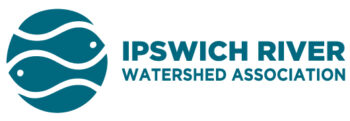Middleton: drive through this central watershed town and you may notice green posts placed alongside the road at various spots. The posts mark and name the places where roads cross the Ipswich River and its tributaries as they flow through town. Tributaries vary in sizes and in the openness of their banks. Without these posts, many of us would drive by without knowing surface water flowed just beneath the road.
Begun by the Middleton Stream Team, this stream crossing project began in 2004. . The volunteer group has now installed a total of 25 stream/river crossing signs throughout the town of Middleton. Inspired by the Middleton Stream Team, the Ipswich River Watershed brought a stream crossing project to Wilmington, our headwaters community. Efforts there were largely spearheaded by the wonderful Suzanne Sullivan (RiverWatch monitor, birder extraordinaire and lifelong friend of the river). Working in partnership with the Town of Wilmington’s Director of Public Works Michael Woods, seven stream crossing signs were installed along the main stem of the Ipswich River as well as three of its tributary streams, Lubber’s Brook, Martin’s Brook and Maple Meadow Brook.
Why label stream crossings? Our water is something that is all too easy to become disconnected from, especially in New England, a place of hilly topography where the lowest points tend towards the swampier end of the spectrum. Water seems to always be falling from the sky, pooling on pavement and flooding basements (the exception being the extremely dry months of August and September where we habitually get little to no rainfall.)
However, despite the presence of all this water, of the familiarity of water available on demand, our freshwater remains a vital resource of which we should be more aware. Sea level may be rising, but across the globe we are witnessing a freshwater crisis. Whether it’s the pattern of drought and fire that California has been struggling with, or the looming approach of Day Zero in the Cape Town water crisis, water is a world issue. We’re privileged to have so much around us. It’s the source of our household water, fuels our agriculture, and provides recreation and beauty to our communities.
How often, however, have you seen garbage scattered along the road? What amount of salt was scattered on the roads for a single snowstorm, never mind a whole season’s worth? We hope that by noticing where our daily paths cross over water, more people will think about, and care about, what might be getting into our water.
The signage project is part of a larger effort to establish the Ipswich River as a Water Trail. Phase I of the project, which involved revitalizing several kiosks along the river, was completed back in 2016 thanks to a grant from the Essex National Heritage Commission. Phase II, also funded by an ENHC grant, is now under way revitalizing and repairing existing kiosks and adding a new kiosk at Salem Road in Topsfield. The Ipswich River gathers water from dozens of tributary streams over a 155 square mile watershed area before emptying into Plum Island Sound and the Great Marsh in Ipswich.The river provides water for 350,000 residents and businesses. Our goal is to place signs at road crossings in all 14 towns along the river in the watershed. Keep your eyes out for new signs popping up. When you see them, think about your water and what it means to you.
